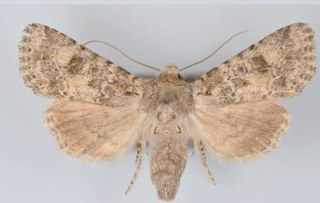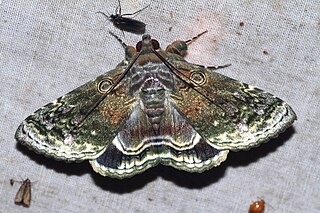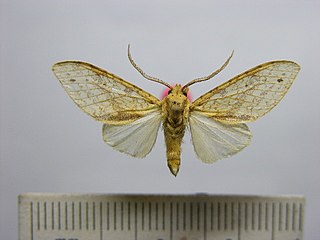
Hulodes caranea is a species of moth of the family Erebidae first described by Pieter Cramer in 1780. It is found from India, Sri Lanka, Myanmar, Java, Hong Kong to Queensland and New Guinea, it is also found on the Marianas and Carolines.

Eudocima materna, the dot-underwing moth, is a moth of the family Erebidae found in widespread parts of the world, mainly in tropical Asia extending to New Guinea and Australia as well as in Africa. Reports from the United States, Canada and the French Antilles are now considered to be Eudocima apta. The species can be differentiated from other Eudocima moths by the presence of small central black dot in each hindwing. The species was first described by Carl Linnaeus in his 1767 12th edition of Systema Naturae.

Aseptis catalina is a moth of the family Noctuidae first described by John Bernhardt Smith in 1899. It is found in the deserts of Arizona, California and Baja California in Mexico.

Aseptis characta is a moth of the family Noctuidae first described by Augustus Radcliffe Grote in 1880. It is widespread in western North America, where it is found in the western Great Plains, Great Basin, and Pacific regions from British Columbia, Alberta, and Saskatchewan to Colorado, Utah, northern Arizona and southern California. The species occurs in dry habitats like sagebrush steppe, juniper woodlands, and open forest from sea level to 2,500 meters.
Nilgerides is a monotypic moth genus of the family Erebidae. Its only species, Nilgerides trifasciata, is known from Sumatra. Both the genus and the species were first described by Michael Fibiger in 2010.
Asylemissa is a monotypic moth genus of the family Erebidae. Its only species, Asylemissa comma, is known from north-eastern Thailand. Both the genus and the species were first described by Michael Fibiger in 2010.
Clarior is a monotypic moth genus of the family Erebidae. Its only species, Clarior kitchingi, is known from northern Thailand. Both the genus and the species were first described by Michael Fibiger in 2010.
Bruma parvus is the only species in the monotypic moth genus Bruma of the family Erebidae. It is known from North Sumatra in Indonesia. Both the genus and the species were first described by Michael Fibiger in 2010.

Ischyja manlia is a species of moth of the family Noctuidae first described by Pieter Cramer in 1776. It is found in the Indian subregion, Sri Lanka, Myanmar, Thailand, China, Okinawa, Sundaland, Sulawesi, Korea, the southern Moluccas, Australia (Queensland) and Palau.

Cyclodes omma is a moth of the family Erebidae. It is found from the Oriental tropics to the Moluccas, including India, Nepal, Vietnam, Cambodia, Myanmar, Thailand, Malaysia, Java, Bali, Sumatra, Timor, Sri Lanka, Flores, Sulawesi, the Philippines, China and Taiwan.

Spilosoma clava is a species of moth of the family Erebidae. It was described by Alfred Ernest Wileman in 1910. It is found in Taiwan.

Paectes obrotunda is a moth of the family Euteliidae first described by Achille Guenée in 1852. It is found in Brazil. The species is only known from the female holotype. Formerly, the species was recorded from Southern North America through Central America to South America. It is also found on the Greater Antilles and Lesser Antilles. These records were based on misidentifications.

Paectes similis is a moth in the family Euteliidae first described by Michael G. Pogue in 2013. It is found in the north-eastern Brazilian state of Pernambuco.

Lophocampa debilis is a moth of the family Erebidae. It was described by William Schaus in 1920. It is found in Mexico, Costa Rica and Guatemala.
Drasteria pulchra is a moth of the family Erebidae first described by William Barnes and James Halliday McDunnough in 1918. It is found in North America, where it has been recorded from California.

Cotana dubia is a moth in the family Eupterotidae. It was described by George Thomas Bethune-Baker in 1904. It is found in New Guinea.

Kessleria alpmaritimae is a moth of the family Yponomeutidae. It is found only in the Marguareis Massif, in the French Alpes Maritimes. The habitat consists of rocky areas on calcareous soil.

Lacinipolia dimocki is a moth in the family Noctuidae. It is found on the eastern slope of the Washington Coast Ranges to southern California.

Aseptis serrula is a moth of the family Noctuidae first described by William Barnes and James Halliday McDunnough in 1918. It is found in the lower mountain-desert transition zone and in high desert such as the Mojave, Colorado, and Sonora deserts of south-eastern California, Nevada, Arizona and Baja California.

Macronoctua onusta, commonly known as the iris borer, is a species of cutworm or dart moth in the family Noctuidae. It is found in North America.
















